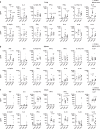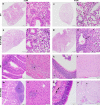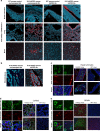Lethality of SARS-CoV-2 infection in K18 human angiotensin-converting enzyme 2 transgenic mice
- PMID: 33257679
- PMCID: PMC7705712
- DOI: 10.1038/s41467-020-19891-7
Lethality of SARS-CoV-2 infection in K18 human angiotensin-converting enzyme 2 transgenic mice
Abstract
Vaccine and antiviral development against SARS-CoV-2 infection or COVID-19 disease would benefit from validated small animal models. Here, we show that transgenic mice expressing human angiotensin-converting enzyme 2 (hACE2) by the human cytokeratin 18 promoter (K18 hACE2) represent a susceptible rodent model. K18 hACE2 transgenic mice succumbed to SARS-CoV-2 infection by day 6, with virus detected in lung airway epithelium and brain. K18 ACE2 transgenic mice produced a modest TH1/2/17 cytokine storm in the lung and spleen that peaked by day 2, and an extended chemokine storm that was detected in both lungs and brain. This chemokine storm was also detected in the brain at day 6. K18 hACE2 transgenic mice are, therefore, highly susceptible to SARS-CoV-2 infection and represent a suitable animal model for the study of viral pathogenesis, and for identification and characterization of vaccines (prophylactic) and antivirals (therapeutics) for SARS-CoV-2 infection and associated severe COVID-19 disease.
Conflict of interest statement
The authors declare no competing interests.
Figures








Similar articles
-
The K18-Human ACE2 Transgenic Mouse Model Recapitulates Non-severe and Severe COVID-19 in Response to an Infectious Dose of the SARS-CoV-2 Virus.J Virol. 2022 Jan 12;96(1):e0096421. doi: 10.1128/JVI.00964-21. Epub 2021 Oct 20. J Virol. 2022. PMID: 34668775 Free PMC article.
-
A human-ACE2 knock-in mouse model for SARS-CoV-2 infection recapitulates respiratory disorders but avoids neurological disease associated with the transgenic K18-hACE2 model.mBio. 2025 May 14;16(5):e0072025. doi: 10.1128/mbio.00720-25. Epub 2025 Apr 24. mBio. 2025. PMID: 40272151 Free PMC article.
-
Infectious Clones Produce SARS-CoV-2 That Causes Severe Pulmonary Disease in Infected K18-Human ACE2 Mice.mBio. 2021 Apr 20;12(2):e00819-21. doi: 10.1128/mBio.00819-21. mBio. 2021. PMID: 33879586 Free PMC article.
-
K18- and CAG-hACE2 Transgenic Mouse Models and SARS-CoV-2: Implications for Neurodegeneration Research.Molecules. 2022 Jun 28;27(13):4142. doi: 10.3390/molecules27134142. Molecules. 2022. PMID: 35807384 Free PMC article. Review.
-
COVID-19 preclinical models: human angiotensin-converting enzyme 2 transgenic mice.Hum Genomics. 2020 Jun 4;14(1):20. doi: 10.1186/s40246-020-00272-6. Hum Genomics. 2020. PMID: 32498696 Free PMC article. Review.
Cited by
-
Expression of the ACE2 virus entry protein in the nervus terminalis reveals the potential for an alternative route to brain infection in COVID-19.bioRxiv [Preprint]. 2021 Jun 7:2021.04.11.439398. doi: 10.1101/2021.04.11.439398. bioRxiv. 2021. Update in: Front Cell Neurosci. 2021 Jul 05;15:674123. doi: 10.3389/fncel.2021.674123. PMID: 33880469 Free PMC article. Updated. Preprint.
-
Obesity and metabolic dysfunction drive sex-associated differential disease profiles in hACE2-mice challenged with SARS-CoV-2.iScience. 2022 Oct 21;25(10):105038. doi: 10.1016/j.isci.2022.105038. Epub 2022 Sep 2. iScience. 2022. PMID: 36068847 Free PMC article.
-
Neutralizing and protective human monoclonal antibodies recognizing the N-terminal domain of the SARS-CoV-2 spike protein.Cell. 2021 Apr 29;184(9):2316-2331.e15. doi: 10.1016/j.cell.2021.03.029. Epub 2021 Mar 16. Cell. 2021. PMID: 33773105 Free PMC article.
-
Monoclonal Antibodies Specific for SARS-CoV-2 Spike Protein Suitable for Multiple Applications for Current Variants of Concern.Viruses. 2022 Dec 31;15(1):139. doi: 10.3390/v15010139. Viruses. 2022. PMID: 36680179 Free PMC article.
-
Platelet activation by SARS-CoV-2 implicates the release of active tissue factor by infected cells.Blood Adv. 2022 Jun 28;6(12):3593-3605. doi: 10.1182/bloodadvances.2022007444. Blood Adv. 2022. PMID: 35443030 Free PMC article.
References
Publication types
MeSH terms
Substances
LinkOut - more resources
Full Text Sources
Other Literature Sources
Medical
Molecular Biology Databases
Miscellaneous

